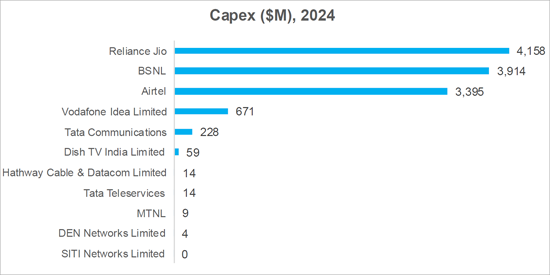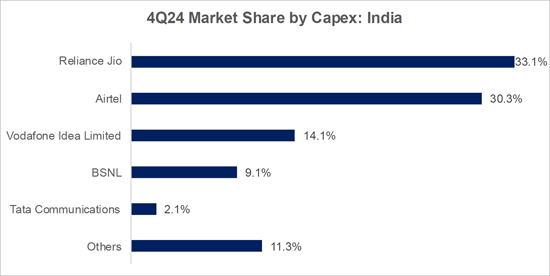|
|
市場調査レポート
商品コード
1738472
インドの設備投資:2025年第1四半期は3年ぶりに緩やかな減速へIndia Capex Starts to Ease in 1Q25 after 3 Big Years |
||||||
|
|||||||
| インドの設備投資:2025年第1四半期は3年ぶりに緩やかな減速へ |
|
出版日: 2025年06月02日
発行: MTN Consulting, LLC
ページ情報: 英文 8 Pages
納期: 即納可能
|
全表示
- 概要
- 目次
政府は、外国の支援なしにスマートでセキュアな通信ネットワークを構築できるローカルサプライヤーエコシステムの開発を目指しています。スタートアップ企業を後押しするには、さらなる支出が必要です。
本レポートでは、インドの通信分野における設備投資 (CAPEX) の短期的な見通しについて調査し、Airtel、BSNL、Jio Platforms、Vodafone Idea (Vi) といった主要事業者の2025年第1四半期の決算をもとに、現在の支出傾向がこれまでの予測とどう違うのかを分析し、投資判断に影響を与える主な要因を整理します。また、ベンダーへの影響や、AI、大規模言語モデル (LLMs) 、データセンターといった新しい分野での動きについても紹介します。
ビジュアル
図2:インドの主要設備投資支出企業
CY24 vs 4Q24 ($M and % total)


出所MTNコンサルティング
インドの2024年の通信部門は、設備投資が140億ドル、収益が410億ドルとなり、それぞれ世界全体の4.7%と2.3%を占めました。インドの設備投資対収益比率 (資本集約度) は3年連続で30%を超えています。しかし、業界の規模や戦略的な重要性にもかかわらず、インドの主要通信事業者の多くは、今後数年間で設備投資を縮小する方針を示しています。この傾向は当社の予測とは一致していますが、インド政府の政策目標とは相反しています。
新たな政策イニシアチブは、従来よりも資金力があり、将来を見据えた形で、活気ある国内通信技術エコシステムの育成を目指すものです。しかし、次世代通信機器を開発する国内のスタートアップ企業は、実環境でのテストや改良の機会を必要としています。ところが、通信事業者が収益性回復のために予算を引き締める中、そうした機会が縮小しつつあります。
このままの流れが続けば、インドは自らのイノベーション目標を損なうリスクを抱えることになります。現実的な短期的解決策としては、BSNLによる本格的な5Gネットワークの大規模展開に政府が主導的に関与することや、全国的な5G構築を目指すViへの優遇措置、インド製の通信機器を海外市場に魅力的に見せるための補助金や各種インセンティブの提供が考えられます。こうした取り組みは、Astrome Tech、Coral Telecom、Frog Cellsat、Galore Networks、Niral Networks、Qbit Labs、Qnu Labs、Prenishq、Resonous Tech、Saankhya Labs、Scytale Alpha、Signaltron、Sooktha、VVDN、WiSig などの注目のインド系スタートアップ企業の支援につながります。
調査範囲
掲載組織
|
|
|
目次
サマリー
市場背景:インド
2025年第1四半期の業績
BSNL
Bharti Airtel
Jio Platforms
Vodafone Idea (Vi)
付録
図表一覧
The government aims to develop a local ecosystem of suppliers able to build smart & secure communications networks without foreign help. More spending is needed to give the startups a boost.
This brief examines the near-term outlook for telecom capital expenditures (capex) in India, based on the 1Q25 earnings of key operators: Airtel, BSNL, Jio Platforms, and Vodafone Idea (Vi). It analyzes how current spending patterns compare with previous forecasts, highlights the main forces shaping investment decisions, explores implications for vendors, and discusses trends in emerging areas such as AI, large language models (LLMs), and data centers.
VISUALS
Figure 2: Major capex spenders in India,
CY24 versus 4Q24 ($M and % total)


Source: MTN Consulting
India closed 2024 with $14.0 billion in telco capex and $41.0 billion in revenues, representing 4.7% and 2.3% of global industry totals, respectively. India's capex to revenue ratio, or capital intensity, has remained above 30% for three straight years. Yet despite the sector's scale and strategic importance, most Indian telcos are now guiding capex downward over the next few years. That trend is aligned with our forecasts, but at odds with the Indian government's policy ambitions.
New policy initiatives aim to foster a vibrant domestic telecom tech ecosystem, better funded and more forward-looking than past efforts. But local startups developing next-gen telecom gear need real-world opportunities to test and refine their solutions. Those opportunities are set to shrink as telcos tighten their budgets to restore profitability.
Absent a shift in trajectory, India risks undercutting its own innovation goals. The most practical near-term solution? A government-led push for BSNL to deploy true 5G networks at scale, favorable treatment for Vi as it attempts to build out nationwide 5G, plus subsidies and other enticements aimed to make local Indian gear attractive to overseas buyers. That would help such Indian startups making waves like Astrome Tech, Coral Telecom, Frog Cellsat, Galore Networks, Niral Networks, Qbit Labs, Qnu Labs, Prenishq, Resonous Tech, Saankhya Labs, Scytale Alpha, Signaltron, Sooktha, VVDN, and WiSig.
Coverage
Organizations mentioned:
|
|
|
Table of Contents
Summary
Market background - India
1Q25 results
BSNL
Bharti Airtel
Jio Platforms
Vodafone Idea (Vi)
Appendix
List of Figures and Tables
- Figure 1: Capex forecast for India telco market and recent changes
- Figure 2: Major capex spenders in India, CY24 versus 4Q24 ($M and % total)
- Figure 3: BSNL capex, capital intensity, and share of global capex
- Figure 4: Airtel capex, capital intensity, and share of global capex
- Figure 5: Jio Platforms capex, capital intensity, and share of global capex
- Figure 6: Vodafone Idea (Vi) capex, capital intensity, and share of global capex






